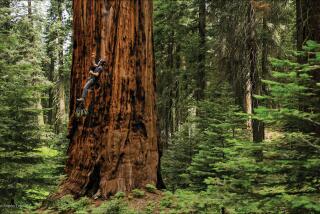Developer Scraps His Plans for Subdivision on Plateau
RIVERSIDE â In a crucial victory for environmentalists, a Riverside County developer agreed Saturday to scrap plans for a sprawling subdivision on an ecologically sensitive plateau and instead will sell his property for open space.
After nine months of negotiations, Won Yoo, president of RANPAC Inc., announced he will sell his land on the Santa Rosa Plateau near Lake Elsinore to the California Nature Conservancy for $35.4 million.
The conservancy is expected to merge Yooâs 3,825-acre parcel with a smaller nature preserve it already owns on the scenic plateau.
The bulk of the money going to buy the land, where Yoo once intended to build almost 4,000 homes, will come from the coffers of Riverside County and the Metropolitan Water District. MWD is participating because it needs to acquire open space to compensate for habitat that will be consumed by a reservoir to be built elsewhere in Riverside County.
Nature Conservancy officials, who acted as negotiators, said the deal is the largest financial transaction in the 40-year history of the nonprofit organization.
Gleeful environmentalists said the purchase would represent one of the most significant open space acquisitions in recent Southern California history. Under the agreement, funding must be obtained by March 29 or Yoo could proceed with development plans.
Because of its isolation in the Santa Ana Mountains and relatively undisturbed status, the plateau hosts an extraordinary wealth and diversity of plant and animal species, many of them threatened.
âWe are just thrilled that this treasure has been saved,â said Dan Silver, a Los Angeles physician and president of the grass-roots group Preserve Our Plateau. âItâs a tremendous accomplishment for all of these parties to work together and come up with the resources to protect such an important place in difficult financial times.â
Riverside County Supervisor Walt Abraham, whose district includes the plateau, described the purchase as an important piece of the rapidly growing countyâs effort to preserve pockets of open space.
âThis place has so many unusual, beautiful features,â Abraham said. âEach time I go up there I discover something new. . . . I came to realize that the people who were yelling about saving this place were right all along.â
Yoo, a home builder with large-scale projects throughout the state, announced on Earth Day last year that he would negotiate with those pushing for public acquisition of the plateau. In a statement released Saturday, the developer said the sale agreement is âa preview of how businesses will have to operate in the 1990s if they are going to be successful.
âThe business community must do their part in cooperating with nature and the environment by offering creative solutions that allow for win-win outcomes,â Yoo said. âThatâs what we have done here today.â
Perched on the edge of the Cleveland National Forest in southwestern Riverside County, the Santa Rosa Plateau represents a remnant of old California. Its acres of rolling native grassland are sprinkled with dense groves of rare Engelmann oak trees and host wildlife ranging from badgers and mountain lions to golden eagles and the vanishing burrowing owl.
Yoo, who purchased his chunk of the plateau in 1988 for $15.5 million, initially proposed building 3,800 homes and condominiums, a golf course and shopping facilities on the site. Although RANPAC offered to set aside 2,000 acres as open space and save all but 10 of the siteâs 2,400 oak trees, critics said such steps could not blunt the impact of the massive project.
Dave Dillon, director of land development for RANPAC, said Yoo was persuaded to sell after seeing âit was the communityâs desire to preserve what is a beautiful and sensitive area.
âThe environmentalists put their money where their mouths are, frankly, so weâre happy to cooperate,â Dillon said.
Chris Kelly, director of protection for the conservancyâs California office, said the MWD and Riverside County are expected to share about $30.1 million of the purchase price.
The conservancy, aided by a private foundation and donations from members, hopes to contribute about $300,000, and $5 million is expected from a state habitat acquisition fund.
More to Read
Sign up for Essential California
The most important California stories and recommendations in your inbox every morning.
You may occasionally receive promotional content from the Los Angeles Times.










